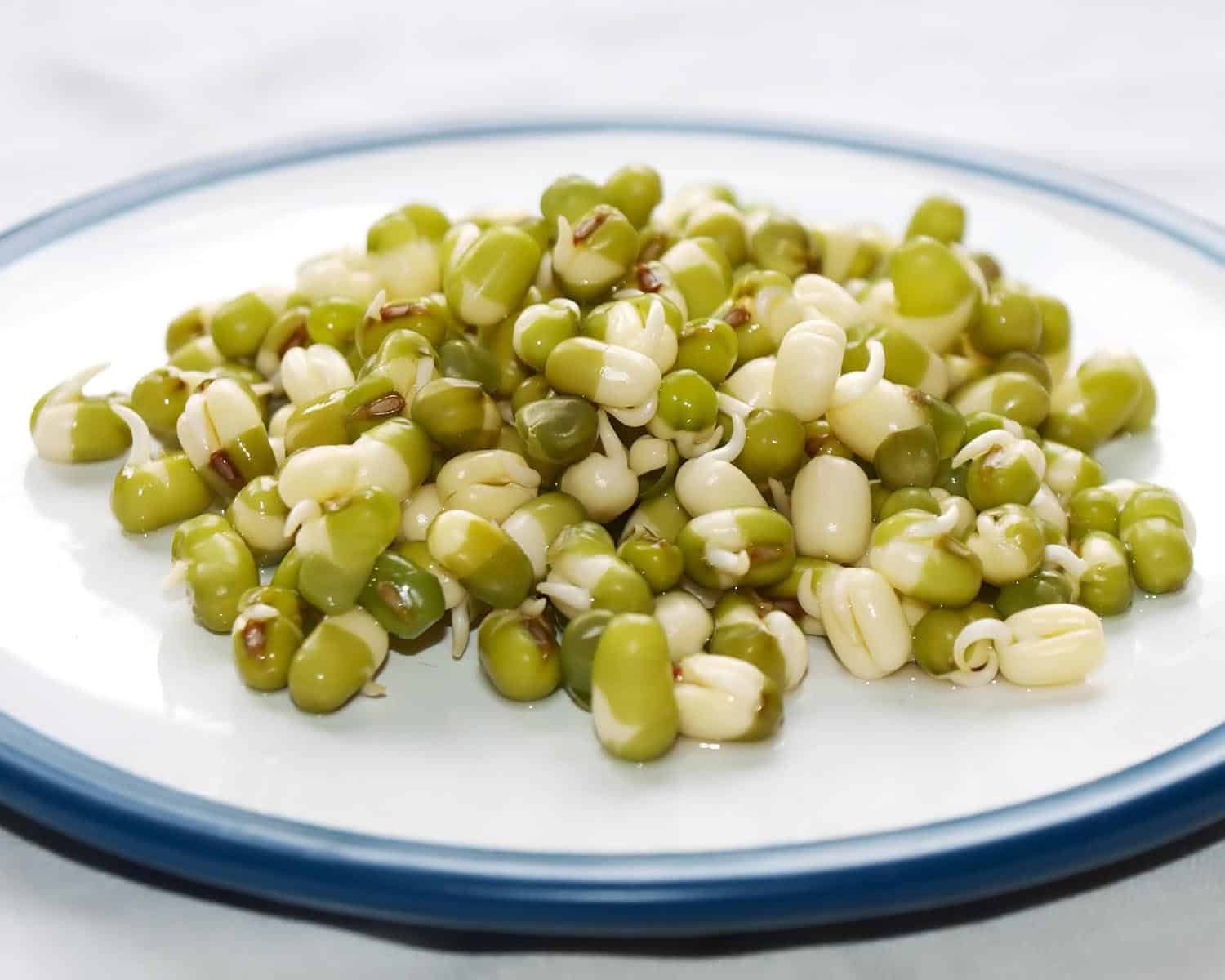Mung Beans Nutrition, Top Benefits, And How to Sprout

- What Are Mung Beans?
- Mung Beans Nutrition Explained
- Top 5 Mung Beans Benefits Explained
- 1. Reduce Chronic Disease Risk
- 2. Reduce Risk Of Heart Disease
- 3. Aid In Digestive Health
- 4. Lower Blood Sugar Levels
- 5. Benefits For Hair And Skin
- How To Sprout Mung Beans
- 1. Jar Method
- 2. Colander Method
- Mung Bean Salad Recipe
- Conclusion
When I was a kid (and still today) I loved eating lentils. One of my favorite dishes was white rice, lentils, and a sunny side up egg. It’s very easy and quick to cook, and it is healthy! So when I came across mung beans, I was curious as to how I could incorporate them into my diet. I am already a huge fan of the bean family and was surprised I had never heard of them before. Mung beans are not very common in American dishes, but are actually very easy to find. If you’re looking to add new flavors or improve your diet, or are just plain curious, keep reading to find out more about mung beans!
What Are Mung Beans?

Green mung beans.
Mung Beans are of Indian origin and have been around for thousands of years. They are popular in dishes in India, China, and various countries in Southeast Asia. The small, green bean (Vigna radiata) is part of the bean family, alongside lentils, green peas, adzuki beans, and alfalfa sprouts.
There is a lot of confusion between lentils and beans (and dals and pulses but that is for another article). Lentils and beans are actually not the same bean. Lentils are a legume and differ from beans in shape and taste. While lentils look like a lense, beans are much larger. Mung beans are not lentils, and some even have reclassified them from belonging in the bean cohort.
Although not as popular as chickpeas and black beans in the U.S., mung beans can be found in protein powders, salads, canned soups, and are a common ingredient in many restaurants (usually referred to as bean sprouts). Additionally, you can purchase these beans in most health food stores.
In terms of taste and texture, mung beans can be sweet or savory and are eaten as sprouts or dried beans. They can also be eaten with or without their skin.
These beans are so healthy some even call them an ancient superfood or food of the angels.
Mung Beans Nutrition Explained
Mung Beans definitely deserve their nickname. The magic beans contain many nutrients, are filling, and are considered useful in defending against many chronic and age-related diseases. They are jam-packed with vitamins and minerals including manganese, magnesium, phosphorus, potassium, iron, copper, zinc, Vitamins B1, B2, B3, B5, B6, and selenium.
These beans have healthy antioxidants which neutralize potentially dangerous free radicals. They can reduce your risk of heart disease, and diabetes. They also help lower cholesterol. The soluble fiber and resistant starch promote digestive health. Another reason to eat these beans is that they actually will reduce hunger by lowering levels of gherlin (hunger hormone) and at the same time are low in calories, fat, cholesterol, sodium, and sugar. They are also high in folate (B9), iron, and protein, which make them extra beneficial to eat if you are pregnant (but not in raw form). Mung Beans are also kosher and vegan.
Top 5 Mung Beans Benefits Explained

Benefits of mung beans for your health.
1. Reduce Chronic Disease Risk
As mentioned in the section above, mung beans are very nutritious. They contain many healthy antioxidants that can reduce the risk of chronic disease. They neutralize potentially harmful molecules called free radicals. Free radicals are associated with chronic inflammation, heart disease, and many other diseases.
Studies show that mung beans can neutralize free radical damage in the body. If you want to benefit from the antioxidants, it is better to eat the mung bean in its sprouted version. The sprouted version contains six times more antioxidants.
2. Reduce Risk Of Heart Disease
Your heart hearts mung beans! By eating these healthy beans, your helping your heart stay healthy. These beans increase your digestive and metabolic rate, lowering your cholesterol by reducing the accumulation of cholesterol in the arterial walls and capillaries. Mung beans also decrease the chance of heart disease by lowering blood pressure. Nutrients such as potassium, magnesium, and fiber in the beans are linked to significantly lowering the risk of high blood pressure. Protein fragments called peptides are also related to reducing high blood pressure. Peptides reduce angiotensin-converting enzyme activity which constricts blood vessels.
Currently, heart diseases are the leading cause of death in America. Make sure to take care of your heart by eating one serving of legumes (such as mung beans) per day.
3. Aid In Digestive Health

Stomach Ache
Mung Beans have soluble fiber (pectin) and resistant starch which promote digestive health. Pectin speeds up the movement of food through your gut which keeps your bowels regular. Meanwhile, resistant starch nourished healthy bacteria in the gut. Bacteria digest the resistant starch and turns into butyrate, a short-chain fatty acid. Butyrate nourish colon cells and promote the gut’s immune defenses.
Mung beans also increase your body’s formation of friendly sugars. Friendly sugar can be digested easily and doesn’t circulate in the blood. Additionally, carbs found in mung beans are easier to digest than those found in other legumes.
4. Lower Blood Sugar Levels
Fiber, protein, and antioxidants in mung beans help slow the release of sugar in your bloodstream. Additionally, sugar in these bean is easily digestible and converts to ATP so it doesn’t circulate in blood. This helps lower blood sugar levels and aids insulin. If you have diabetes or are pre-diabetic, having a healthy blood sugar levels is essential, but can be very difficult.
Two antioxidants called vitexin and isovitexin are linked to lowering blood sugar levels and helping insulin work more efficiently. These antioxidants inhibit the formation of advanced glycation endproducts (AGEs). AGEs can damage kidney and retina tissue which increases diabetic complications of kidney dysfunction and blindness.
One study with human volunteers found 45% lower glucose response when eating a 50-gram portion of low-glycemic beans like mung beans compared to eating grains, breads, pasta and cereals. This makes beans amazing for type II diabetics.
5. Benefits For Hair And Skin

Woman with soft and smooth healthy hair.
Do you want to reduce wrinkles, age spots, and age lines? What about have shinier and healthier looking hair and skin?
Consuming copper regularly by eating mung beans will do all that. Copper increases shine and radiance to the human skin. Using mung bean as a scrub is very easy and will leave you with cleaner and reduced pores. It will also remove blackheads, excessive oil, and unnatural glares. Mung bean hair masks can also add shine to hair by restoring normal pH levels of your scalp and nourish dry and damaged hair.
How To Sprout Mung Beans

Sprouted beans.
There are a couple ways to sprout mung beans. In this article I will share the best tips for using the jar and colander method.
Sprouting Directions Jar Method
For the best results you will want to grow mung beans in the dark as light causes bitterness and less sprouting. Additionally, you will need a lot of water as the beans will double in size. You should not use an airtight container so a jar covered with mesh and secured with a rubber band will suffice. You can also use a lid but leave a gap.
- Soak 3-5 tablespoons of seeds in a jar
- Leave to soak for 8-12 hours somewhere dark
- Drain and rinse every 12 hours. This will prevent spoiling or bacteria growth.
- After 2 days you will notice nicely sprouted beans but you can sprout them up to 5 days.
Sprouting Directions Colander Method
If you want to grow bean sprouts at a higher quantity you can use a large colander. You can find these ingredients at an Asian Supermarket. One colander needs holes and one without. In the container it could be useful to spread wet paper towels over the colander with holes just so the beans don’t fall through.
- The first step is to soak the beans in a bowl for 12-24 hours. You can rinse it multiple times to ensure the beans are clean.
- After, pour your bowl of water and beans onto the colander and spread the beans. Leave in the dark by covering the colander with a towel.
- Water the sprouts 2-3 times a day by using a spray bottle or just a jug of water. Cover and store.
- Let the water drain, cover the beans with a towel and put them away until day 6 or 7 (whenever they are ready)
Mung Bean Salad Recipe

Mung bean salad.
For a really easy mung bean salad start by rinsing and cooking 1 cup of mung beans in a saucepan with water. Simmer for 40 minutes until the beans are soft but not too squishy. Drain the water and allow the beans to cool. Toss the mung beans in a bowl with red onion, cherry tomatoes, avocado, and sweetcorn.
Once you’ve combined the ingredient for the salad you’ll want to make a dressing that really brings out the flavors of the vegetables. Mix 1 tbsp lemon juice, 3 tbsp apple cider vinegar, and 3 tbsp olive oil well before pouring generously over your salad. Add salt and pepper to taste. And that’s it! You’ve got yourself a delicious mung bean salad for both summer and spring!
Conclusion
You can’t deny the amazing benefits of mung beans. The super beans can be easily incorporated into your food. Even though they take a couple days to sprout, actually growing the beans is a very simple process. Sprouting the beans and incorporating them into your diet can also be a very rewarding experience.
Mung beans can be purchased at an Asian supermarket or several organic stores such as Whole Foods, or even Amazon. I definitely look forward to testing some of the recipes myself.



